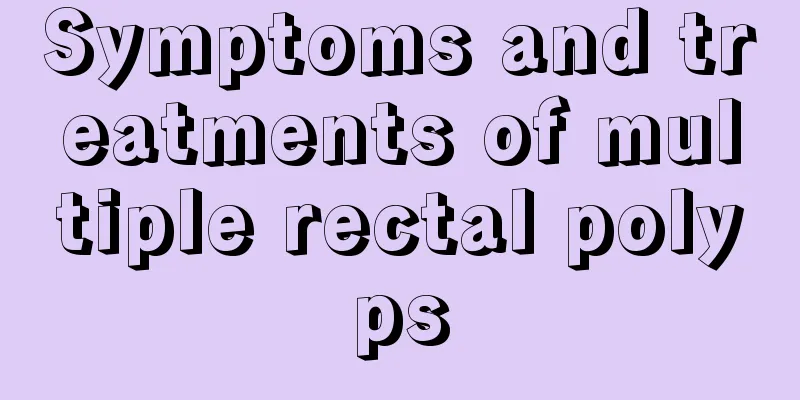Symptoms and treatments of multiple rectal polyps

|
Rectal polyps refer to raised lesions on the surface of the rectal mucosa that protrude into the intestinal cavity. Their pathological properties vary. Some are benign tumors, while others are the result of inflammatory hyperplasia. They are generally similar when observed with the naked eye. So what are the symptoms of multiple rectal polyps? What kind of treatment methods can we adopt? Let’s take a look at it together. symptom: (1) Blood in the stool: fresh blood in small amounts, often staining the surface of the stool. When inflammation occurs, there are symptoms such as mucus and blood in the stool, diarrhea, and tenesmus. (ii) Rectal masses are pedunculated polyps located at the lower end of the rectum. They may protrude from the anus during defecation. They are bright red, round, and cherry-shaped, but may return on their own after defecation. Sessile polyps can only be detected through anal digital examination and anoscopy. (III) Anal digital and endoscopic examinations may palpate single or multiple pedunculated polyps or sessile polyps. The former are more mobile, while the latter are more fixed. Polyps are round and soft. If the polyps become hard, have an uneven surface, and are fixed to the intestinal wall, they may be cancerous. To clarify the nature, take living tissue. (iv) Barium enema helps to understand the distribution of polyps. treat: 1. Electrocautery resection: If the tumor is within the reach of the colonoscope and cannot be removed from the anus, a snare can be placed through the endoscope to encircle the pedicle and perform electrocautery resection. Polyps were examined pathologically. Electrocautery of polyps is not safe. 2. Transanal removal of polyps that can be removed from the anus: use an anoscope or dilator to dilate the anus, clamp the polyp with forceps, tie it with silk thread at the base of the anus, and remove the polyp. After the removal of a broad-based polyp, the mucosal wound should be sutured. 3. Open surgery: Polyps are located high and cannot be treated with the above methods. It is necessary to open the abdomen under epidural anesthesia to cut open the anterior wall of the rectum to remove the polyps. If it has already become cancerous, it should be treated as rectal cancer. For multiple familial polyposis, whether the rectum can be preserved is determined based on the distribution of polyps in the rectum. Rectal resection or rectal mucosal stripping, ileoanal anastomosis through the rectal seromuscular sheath, etc. can be performed. 4. Other inflammatory polyps can be treated with antibiotics and hormone retention enemas. In the above article, we analyzed in detail the symptoms of multiple rectal polyps and the treatment methods that can be taken. If this happens to our body, we must pay attention to it and seek treatment in time. If we are still unsure about our symptoms, we must go to the hospital for a thorough examination. |
<<: Symptoms and treatment of vitamin D deficiency
>>: Diet therapy to prevent wounds from forming scabs
Recommend
What are the diagnostic tests for cystic renal cancer
We are already familiar with kidney cancer. This ...
The liver cancer has spread to the blood vessels in the late stage. The doctor said that I can only live for three to six months. What should I do now?
The liver cancer has spread to the blood vessels....
The difference between tussah silk and mulberry silk
Usually when we buy various silk products, we alw...
Pseudomyopia treatment
Is myopia very common? Nowadays, there are a lot ...
Memory loss or mental sub-health
If mental sub-health occurs, we must face the pro...
What are the causes of canthal malignant melanoma
What are the causes of canthal malignant melanoma...
What's going on when the gums don't cover the roots of the teeth?
The structure of teeth is very complex. Generally...
What type of legs will have wear on the outside of the sole
In life, everyone's walking posture is differ...
Which one is better, Xuhanting or Yupingfeng
For some friends who are prone to night sweats, C...
The difference between thread-carving rhinoplasty and prosthesis
We all know that content technology is becoming m...
What are the common infectious diseases in spring
Spring is the season with a high incidence of inf...
Is a tumor on the nasal septum nasopharyngeal cancer?
The tumor in the nasal septum may not be nasophar...
Tips for curing drowsiness
Sleep allows our body to get enough rest and thus...
What are some good ways to treat vitiligo
Speaking of vitiligo, I believe most people think...
Can you briefly explain what liver mass is?
Liver mass means that this situation will be disc...









